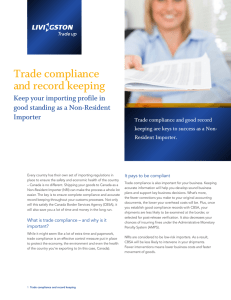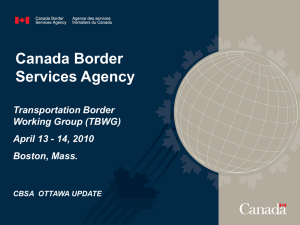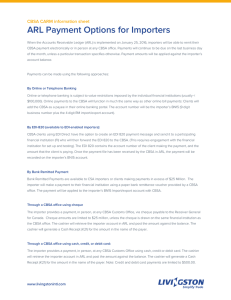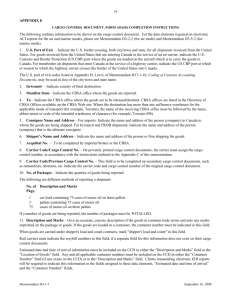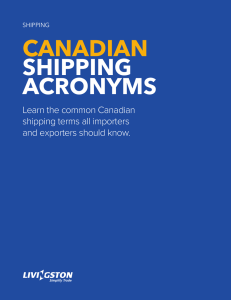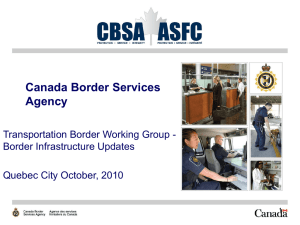What is AMPS? Step 2
advertisement
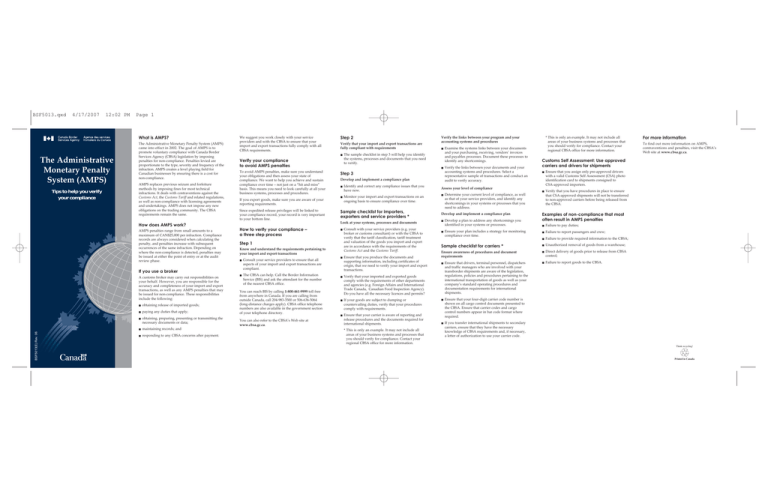
BSF5013.qxd 4/17/2007 12:02 PM Page 1 What is AMPS? The Administrative Monetary Penalty System (AMPS) Tips to help you verify your compliance The Administrative Monetary Penalty System (AMPS) came into effect in 2002. The goal of AMPS is to promote voluntary compliance with Canada Border Services Agency (CBSA) legislation by imposing penalties for non-compliance. Penalties levied are proportionate to the type, severity and frequency of the infraction. AMPS creates a level playing field for Canadian businesses by ensuring there is a cost for non-compliance. AMPS replaces previous seizure and forfeiture methods by imposing fines for most technical infractions. It deals with contraventions against the Customs Act, the Customs Tariff and related regulations, as well as non-compliance with licensing agreements and undertakings. AMPS does not impose any new obligations on the trading community. The CBSA requirements remain the same. How does AMPS work? AMPS penalties range from small amounts to a maximum of CAN$25,000 per infraction. Compliance records are always considered when calculating the penalty, and penalties increase with subsequent occurrences of the same infraction. Depending on where the non-compliance is detected, penalties may be issued at either the point of entry or at the audit review phase. We suggest you work closely with your service providers and with the CBSA to ensure that your import and export transactions fully comply with all CBSA requirements. ■ obtaining release of imported goods; ■ paying any duties that apply; BSF5013(E) Rev. 06 ■ obtaining, preparing, presenting or transmitting the necessary documents or data; ■ maintaining records; and ■ responding to any CBSA concerns after payment. Verify that your import and export transactions are fully compliant with requirements ■ Verify your compliance to avoid AMPS penalties To avoid AMPS penalties, make sure you understand your obligations and then assess your state of compliance. We want to help you achieve and sustain compliance over time – not just on a “hit and miss” basis. This means you need to look carefully at all your business systems, processes and procedures. If you export goods, make sure you are aware of your reporting requirements. Since expedited release privileges will be linked to your compliance record, your record is very important to your bottom line. How to verify your compliance – a three step process ■ Consult your service providers to ensure that all aspects of your import and export transactions are compliant. The CBSA can help. Call the Border Information Service (BIS) and ask the attendant for the number of the nearest CBSA office. You can reach BIS by calling 1-800-461-9999 toll free from anywhere in Canada. If you are calling from outside Canada, call 204-983-3500 or 506-636-5064 (long-distance charges apply). CBSA office telephone numbers are also available in the government section of your telephone directory. You can also refer to the CBSA’s Web site at www.cbsa.gc.ca. The sample checklist in step 3 will help you identify the systems, processes and documents that you need to verify. Develop and implement a compliance plan ■ Identify and correct any compliance issues that you have now. Monitor your import and export transactions on an ongoing basis to ensure compliance over time. Sample checklist for importers, exporters and service providers * Look at your systems, processes and documents ■ Know and understand the requirements pertaining to your import and export transactions ■ ■ Step 3 ■ ■ ■ ■ ■ Consult with your service providers (e.g. your broker or customs consultant) or with the CBSA to verify that the tariff classification, tariff treatment and valuation of the goods you import and export are in accordance with the requirements of the Customs Act and the Customs Tariff. Ensure that you produce the documents and supporting information, including certificates of origin, that we need to verify your import and export transactions. Ensure that your carrier is aware of reporting and release procedures and the documents required for international shipments. * This is only an example. It may not include all areas of your business systems and processes that you should verify for compliance. Contact your regional CBSA office for more information. Examine the systems links between your documents and your purchasing, receiving, vendors’ invoices and payables processes. Document these processes to identify any shortcomings. Verify the links between your documents and your accounting systems and procedures. Select a representative sample of transactions and conduct an audit to verify accuracy. ■ Determine your current level of compliance, as well as that of your service providers, and identify any shortcomings in your systems or processes that you need to address. Develop and implement a compliance plan ■ Develop a plan to address any shortcomings you identified in your systems or processes. ■ ■ Verify that you have procedures in place to ensure that CSA-approved shipments will not be transferred to non-approved carriers before being released from the CBSA. Examples of non-compliance that most often result in AMPS penalties Failure to pay duties; ■ Failure to report passengers and crew; ■ Failure to provide required information to the CBSA; Sample checklist for carriers * ■ Unauthorized removal of goods from a warehouse; Ensure awareness of procedures and document requirements ■ ■ ■ ■ Ensure your plan includes a strategy for monitoring compliance over time. Ensure that drivers, terminal personnel, dispatchers and traffic managers who are involved with your transborder shipments are aware of the legislation, regulations, policies and procedures pertaining to the international transportation of goods as well as your company’s standard operating procedures and documentation requirements for international shipments. To find out more information on AMPS, contraventions and penalties, visit the CBSA’s Web site at www.cbsa.gc.ca. Ensure that you assign only pre-approved drivers with a valid Customs Self Assessment (CSA) photo identification card to shipments consigned to CSA-approved importers. ■ ■ For more information Customs Self Assessment: Use approved carriers and drivers for shipments Assess your level of compliance Verify that your imported and exported goods comply with the requirements of other departments and agencies (e.g. Foreign Affairs and International Trade Canada, Canadian Food Inspection Agency). Do you have all the necessary licences and permits? If your goods are subject to dumping or countervailing duties, verify that your procedures comply with requirements. * This is only an example. It may not include all areas of your business systems and processes that you should verify for compliance. Contact your regional CBSA office for more information. Verify the links between your program and your accounting systems and procedures ■ Step 1 If you use a broker A customs broker may carry out responsibilities on your behalf. However, you are responsible for the accuracy and completeness of your import and export transactions, as well as any AMPS penalties that may be issued for non-compliance. These responsibilities include the following: Step 2 ■ Direct delivery of goods prior to release from CBSA control; Failure to report goods to the CBSA. Ensure that your four-digit carrier code number is shown on all cargo control documents presented to the CBSA. Ensure that carrier codes and cargo control numbers appear in bar code format where required. If you transfer international shipments to secondary carriers, ensure that they have the necessary knowledge of CBSA requirements and, if necessary, a letter of authorization to use your carrier code. Think recycling! Printed in Canada
